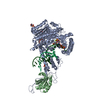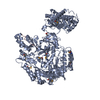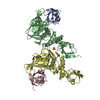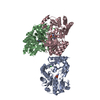+ データを開く
データを開く
- 基本情報
基本情報
| 登録情報 | データベース: EMDB / ID: EMD-13859 | |||||||||
|---|---|---|---|---|---|---|---|---|---|---|
| タイトル | L. pneumophila Type IV Coupling Complex (T4CC) computed from a sample where dotY/Z genes were deleted (referred to as T4CCdeltaDotYZ at 15A) | |||||||||
 マップデータ マップデータ | DotLMN complex from DotYZ mutant - T4CCdeltaDotYZ at 15A | |||||||||
 試料 試料 |
| |||||||||
 キーワード キーワード | Type IV Coupling Complex / T4CC / Type IV Secretion System / T4SS / Membrane protein complex / Membrane complex / DotY / DotZ / DotL / dotM / dotN / IcmSW / Legionella / MEMBRANE PROTEIN / delta DotY/Z | |||||||||
| 機能・相同性 |  機能・相同性情報 機能・相同性情報 | |||||||||
| 生物種 |  | |||||||||
| 手法 | 単粒子再構成法 / クライオ電子顕微鏡法 / 解像度: 15.0 Å | |||||||||
 データ登録者 データ登録者 | Mace K / Meir A / Lukoyanova N / Waksman G | |||||||||
| 資金援助 | European Union, 1件
| |||||||||
 引用 引用 |  ジャーナル: Mol Microbiol / 年: 2022 ジャーナル: Mol Microbiol / 年: 2022タイトル: Proteins DotY and DotZ modulate the dynamics and localization of the type IVB coupling complex of Legionella pneumophila. 著者: Kevin Macé / Amit Meir / Natalya Lukoyanova / Luying Liu / David Chetrit / Manuela K Hospenthal / Craig R Roy / Gabriel Waksman /   要旨: Legionella pneumophila is an opportunistic pathogen infecting alveolar macrophages and protozoa species. Legionella utilizes a Type IV Secretion System (T4SS) to translocate over 300 effector ...Legionella pneumophila is an opportunistic pathogen infecting alveolar macrophages and protozoa species. Legionella utilizes a Type IV Secretion System (T4SS) to translocate over 300 effector proteins into its host cell. In a recent study, we have isolated and solved the cryo-EM structure of the Type IV Coupling Complex (T4CC), a large cytoplasmic determinant associated with the inner membrane that recruits effector proteins for delivery to the T4SS for translocation. The T4CC is composed of a DotLMNYZ hetero-pentameric core from which the flexible IcmSW module flexibly protrudes. The DotY and DotZ proteins were newly reported members of this complex and their role remained elusive. In this study, we observed the effect of deleting DotY and DotZ on T4CC stability and localization. Furthermore, we found these two proteins are co-dependent, whereby the deletion of DotY resulted in DotZ absence from the coupling complex, and vice versa. Additional cryo-EM data analysis revealed the dynamic movement of the IcmSW module is modified by the DotY/Z proteins. We therefore determined the likely function of DotY and DotZ and revealed their importance on T4CC function. | |||||||||
| 履歴 |
|
- 構造の表示
構造の表示
| ムービー |
 ムービービューア ムービービューア |
|---|---|
| 構造ビューア | EMマップ:  SurfView SurfView Molmil Molmil Jmol/JSmol Jmol/JSmol |
| 添付画像 |
- ダウンロードとリンク
ダウンロードとリンク
-EMDBアーカイブ
| マップデータ |  emd_13859.map.gz emd_13859.map.gz | 15.2 MB |  EMDBマップデータ形式 EMDBマップデータ形式 | |
|---|---|---|---|---|
| ヘッダ (付随情報) |  emd-13859-v30.xml emd-13859-v30.xml emd-13859.xml emd-13859.xml | 7.9 KB 7.9 KB | 表示 表示 |  EMDBヘッダ EMDBヘッダ |
| 画像 |  emd_13859.png emd_13859.png | 29.8 KB | ||
| Filedesc metadata |  emd-13859.cif.gz emd-13859.cif.gz | 3.6 KB | ||
| アーカイブディレクトリ |  http://ftp.pdbj.org/pub/emdb/structures/EMD-13859 http://ftp.pdbj.org/pub/emdb/structures/EMD-13859 ftp://ftp.pdbj.org/pub/emdb/structures/EMD-13859 ftp://ftp.pdbj.org/pub/emdb/structures/EMD-13859 | HTTPS FTP |
-検証レポート
| 文書・要旨 |  emd_13859_validation.pdf.gz emd_13859_validation.pdf.gz | 287.1 KB | 表示 |  EMDB検証レポート EMDB検証レポート |
|---|---|---|---|---|
| 文書・詳細版 |  emd_13859_full_validation.pdf.gz emd_13859_full_validation.pdf.gz | 286.7 KB | 表示 | |
| XML形式データ |  emd_13859_validation.xml.gz emd_13859_validation.xml.gz | 6.5 KB | 表示 | |
| CIF形式データ |  emd_13859_validation.cif.gz emd_13859_validation.cif.gz | 7.5 KB | 表示 | |
| アーカイブディレクトリ |  https://ftp.pdbj.org/pub/emdb/validation_reports/EMD-13859 https://ftp.pdbj.org/pub/emdb/validation_reports/EMD-13859 ftp://ftp.pdbj.org/pub/emdb/validation_reports/EMD-13859 ftp://ftp.pdbj.org/pub/emdb/validation_reports/EMD-13859 | HTTPS FTP |
-関連構造データ
- リンク
リンク
| EMDBのページ |  EMDB (EBI/PDBe) / EMDB (EBI/PDBe) /  EMDataResource EMDataResource |
|---|---|
| 「今月の分子」の関連する項目 |
- マップ
マップ
| ファイル |  ダウンロード / ファイル: emd_13859.map.gz / 形式: CCP4 / 大きさ: 103 MB / タイプ: IMAGE STORED AS FLOATING POINT NUMBER (4 BYTES) ダウンロード / ファイル: emd_13859.map.gz / 形式: CCP4 / 大きさ: 103 MB / タイプ: IMAGE STORED AS FLOATING POINT NUMBER (4 BYTES) | ||||||||||||||||||||||||||||||||||||||||||||||||||||||||||||||||||||
|---|---|---|---|---|---|---|---|---|---|---|---|---|---|---|---|---|---|---|---|---|---|---|---|---|---|---|---|---|---|---|---|---|---|---|---|---|---|---|---|---|---|---|---|---|---|---|---|---|---|---|---|---|---|---|---|---|---|---|---|---|---|---|---|---|---|---|---|---|---|
| 注釈 | DotLMN complex from DotYZ mutant - T4CCdeltaDotYZ at 15A | ||||||||||||||||||||||||||||||||||||||||||||||||||||||||||||||||||||
| 投影像・断面図 | 画像のコントロール
画像は Spider により作成 | ||||||||||||||||||||||||||||||||||||||||||||||||||||||||||||||||||||
| ボクセルのサイズ | X=Y=Z: 1.045 Å | ||||||||||||||||||||||||||||||||||||||||||||||||||||||||||||||||||||
| 密度 |
| ||||||||||||||||||||||||||||||||||||||||||||||||||||||||||||||||||||
| 対称性 | 空間群: 1 | ||||||||||||||||||||||||||||||||||||||||||||||||||||||||||||||||||||
| 詳細 | EMDB XML:
CCP4マップ ヘッダ情報:
| ||||||||||||||||||||||||||||||||||||||||||||||||||||||||||||||||||||
-添付データ
- 試料の構成要素
試料の構成要素
-全体 : DotLMN_IcmSW
| 全体 | 名称: DotLMN_IcmSW |
|---|---|
| 要素 |
|
-超分子 #1: DotLMN_IcmSW
| 超分子 | 名称: DotLMN_IcmSW / タイプ: complex / ID: 1 / 親要素: 0 / 詳細: Heterogeneity from DotLMNYZ_IcmSW WT |
|---|---|
| 由来(天然) | 生物種:  |
-実験情報
-構造解析
| 手法 | クライオ電子顕微鏡法 |
|---|---|
 解析 解析 | 単粒子再構成法 |
| 試料の集合状態 | particle |
- 試料調製
試料調製
| 緩衝液 | pH: 8 |
|---|---|
| 凍結 | 凍結剤: ETHANE |
- 電子顕微鏡法
電子顕微鏡法
| 顕微鏡 | FEI TITAN KRIOS |
|---|---|
| 撮影 | フィルム・検出器のモデル: GATAN K2 SUMMIT (4k x 4k) 平均電子線量: 54.0 e/Å2 |
| 電子線 | 加速電圧: 300 kV / 電子線源:  FIELD EMISSION GUN FIELD EMISSION GUN |
| 電子光学系 | 照射モード: FLOOD BEAM / 撮影モード: BRIGHT FIELD |
| 実験機器 |  モデル: Titan Krios / 画像提供: FEI Company |
- 画像解析
画像解析
| 初期モデル | モデルのタイプ: EMDB MAP EMDB ID: |
|---|---|
| 最終 再構成 | 解像度のタイプ: BY AUTHOR / 解像度: 15.0 Å / 解像度の算出法: FSC 0.143 CUT-OFF / 使用した粒子像数: 50210 |
| 初期 角度割当 | タイプ: MAXIMUM LIKELIHOOD |
| 最終 角度割当 | タイプ: MAXIMUM LIKELIHOOD |
 ムービー
ムービー コントローラー
コントローラー

















 Z (Sec.)
Z (Sec.) Y (Row.)
Y (Row.) X (Col.)
X (Col.)






















